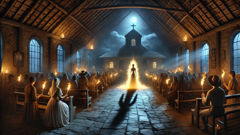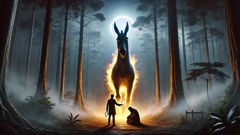Introduction
Moonlight spilled like quicksilver across the rugged hills and red-earth trails of Minas Gerais, Brazil. In the hush of night, ancient trees cast long, tangled shadows over fields where the cerrado grass whispered with secrets. The land held stories—of spirits, saints, and sins whispered by firelight and carried on the wind. Yet none gripped the hearts of villagers more than the legend of the Headless Mule, or as they called her in hushed tones, a Mula Sem Cabeça. This was no ordinary ghost tale, but a living curse that blazed through the darkness, echoing the heartbreak and forbidden desires buried deep within the soul of a young woman named Isabela. Her story began in the dusty heart of a small 19th-century parish town, where the bell tower rose like a hopeful finger toward heaven and every path seemed watched by unseen eyes. The townspeople—humble, devout, and wary—knew that temptation could be deadly, especially when it crossed the sanctity of the church. To love was a gift, but to love the wrong person was a sin that could ignite fires no rain could quench. Isabela’s secret romance with Father Rafael, the young priest with gentle eyes and an earnest heart, unfolded in the fleeting twilight hours. Their moments were stolen and sweet, full of longing glances and whispered prayers for forgiveness. But in a land where the boundaries between the sacred and the profane were as thin as mist, such a secret could not last. One stormy night, as thunder rolled like judgment across the hills, their love was discovered—and so was Isabela’s fate. The ancient curse of the Headless Mule, passed down in trembling voices from generation to generation, was unleashed. Each Friday at midnight, Isabela was doomed to transform: her body became a wild, powerful mule, her head vanished, and from her severed neck poured a torrent of orange fire that lit up the countryside and filled the air with the acrid scent of burning sorrow. The legend said she galloped ceaselessly across the moonlit plains, iron horseshoes sparking against stone, her presence heralded by unearthly shrieks and the flicker of phantom flames. Children huddled beneath blankets, mothers clutched rosaries, and fathers watched the horizon with dread. Yet beneath the terror, there remained a glimmer of hope—a rumor that redemption was possible for the cursed one if only a heart pure and brave enough could face the truth, forgive the sin, and break the spell. It is here, on the edge of fear and faith, that our story unfolds: a journey into the wild beauty and shadowed corners of the Brazilian interior, where love, regret, and redemption chase each other like firelight on the open plains.
Whispers Beneath the Jacaranda: Isabela’s Secret
In the golden haze of late afternoon, when the jacaranda trees scattered their purple blossoms along dusty village streets, Isabela moved with the grace of someone both cherished and cursed. She was known for her kindness—a young woman with gentle hands and a rare smile that softened even the hardest faces at the Saturday market. But there was a sadness in her eyes, a longing that only deepened when she lingered too long outside the cool shadows of the parish chapel.

It was there, beneath the arching boughs and bell tower, that she first met Father Rafael. He was not much older than Isabela, newly arrived from the city and burning with quiet conviction. The villagers admired his piety and his unassuming charm, but only Isabela noticed the way his hands trembled ever so slightly when he spoke of grace and forgiveness. Their conversations began innocently—an offer to carry baskets, a prayer for a sick neighbor. Over weeks, the friendship blossomed into something far more dangerous: a love forged in secret, kindled by the hush of evening and the heavy scent of blooming night-blooming cereus.
Each Friday, as dusk folded itself over the hills, Isabela and Rafael met beneath an old jacaranda at the edge of the cemetery. The world felt suspended in those moments: the cicadas’ hum softened, the air thickened with promise. They spoke of dreams and doubts, fears and futures. But always, guilt coiled around their words—a constant reminder of the boundaries they crossed. Rafael’s vows weighed heavily on his conscience. He begged Isabela to trust that love itself was not a sin, but the secrecy and deception tore at his soul.
Their stolen happiness could not last. Rumors, like wild grassfires, crept through the village. A neighbor glimpsed Isabela slipping from the rectory garden; a child overheard laughter in the confessional. The local priest, old Father Bento, watched Rafael with new suspicion, and Isabela’s mother wept silent tears at night, clutching a faded handkerchief.
One storm-shattered night, a peal of thunder shook the chapel windows as Isabela sought shelter in the vestry. Rafael met her there, both trembling—not from the cold, but from the weight of what they had become. They confessed their love and their fears, swearing to never meet again. But even as they parted, the church doors burst open.
The parish council—led by Dona Lucinda, the stern widow who kept the village’s secrets—stood in the threshold, torches blazing. Their faces were grim, eyes cold with betrayal. Isabela tried to speak, but her voice failed her. Rafael stepped forward, pleading for mercy, but it was too late. The council invoked the ancient curse, their voices echoing with a power older than scripture: a woman who lay with a priest would walk as a beast, headless and aflame, doomed to haunt the land for eternity.
As the last torch guttered out, Isabela fell to her knees. A cold wind swept through the chapel, scattering petals and prayers. Her body convulsed; pain and fire tore through her as darkness swallowed her vision. When she awoke, she was no longer herself. Her body stretched and twisted, hooves pounding against the chapel stones, neck severed and spewing fire into the night. The Headless Mule was born—her screams scattering birds, her sorrow burning brighter than any lantern.
Fire on the Plains: The Headless Mule Roams
The moon hung high and pale over the fields as the Headless Mule thundered into legend. Each Friday at midnight, the villagers heard her before they saw her: an unearthly shriek that rose from the hills, shaking doors and stirring even the bravest dogs to howl and hide. The ground trembled beneath her hooves; sparks shot from her iron shoes as she galloped across stone and red clay, weaving through groves of twisted ipê trees and silent farmsteads.

From her neck—where a human head should be—fire burst forth, bright as a forge and wild as a storm. It poured in waves, lighting the path before her and setting dry grass smoldering in her wake. The villagers watched from their windows as the mule’s infernal glow painted their whitewashed walls orange and gold. Children squeezed together in their hammocks, mothers whispered prayers to saints, and old men recited forgotten spells meant to ward off evil. No one dared go outside until the flames had faded and the first rooster crowed.
For Isabela, the transformation was agony. Her mind remained trapped inside the mule’s powerful body, her memories a cascade of regret and yearning. She saw her mother’s face in every shadow, heard Rafael’s voice in the wind. Each Friday, she tried to stop herself, to resist the urge to run wild—but the curse drove her onward. Her sorrow mingled with fury, and her tears became fire.
The villagers’ fear grew as the months passed. Crops were scorched along her path; a herd of cattle stampeded into the river, never to be seen again. Stories multiplied—some said she could pass through walls like smoke, others that she stole children’s voices for her own shrieks. In every tale, the message was clear: cross the church’s laws, and you would pay with your soul.
Yet even in her terror, Isabela’s presence sparked something else: a stubborn hope that the curse could be undone. The village healer, old Tia Rosina, remembered a fragment of the legend—a pure-hearted soul could break the spell by showing compassion and courage. But none dared approach the mule; her flames were too fierce, her pain too raw.
Meanwhile, Rafael wandered the hills each Friday night, searching for signs of Isabela. He refused to believe she was lost forever. He prayed for guidance, for mercy, for a miracle. But all he found were scorched hoofprints in the morning dew and the faint scent of burning sorrow clinging to the grass.
One autumn night, as the festival of São João approached and the village prepared its bonfires and sweet cakes, a new figure arrived in town—a young man named Lucas. He was a stranger, dark-eyed and quiet, with a limp that told of past hardship. Lucas listened to the stories with curiosity, but where others felt only fear, he sensed something else: a plea for help hidden beneath the mule’s shrieks. Determined to uncover the truth, Lucas vowed to face the Headless Mule and break the ancient curse, no matter the cost.
Redemption’s Path: Lucas Faces the Fire
Lucas was no ordinary wanderer. He had heard stories like this before in his travels—of spirits bound by sorrow, curses entwined with love, and redemption hidden in acts of grace. But nothing compared to what he witnessed in this Brazilian village. The fear was thick in the air; every whispered warning carried centuries of pain. Still, Lucas felt drawn to Isabela’s fate as if it echoed a secret loss in his own past.

In the days before São João, Lucas watched the village prepare. Children strung paper lanterns between trees, old women pounded corn for cakes, and men stacked wood for the great bonfire. The mood was festive by day, but as dusk approached each Friday, celebration soured into dread. Lucas listened to Tia Rosina’s tales by firelight, learning every detail of the curse—how it was rooted in shame, how it could only be broken by compassion and courage.
On the night of the festival, Lucas waited near the old jacaranda tree at the cemetery’s edge. He carried nothing but a small pouch of salt (for protection), a sprig of rosemary (for memory), and an iron horseshoe (for luck). The moon rose, pale and full, as midnight neared. Far off, a shriek split the silence. The ground vibrated. Lucas stood firm as the Headless Mule burst from the trees, a river of fire streaming from her neck, hooves sparking against stone.
He did not run or hide. Instead, Lucas called out to her in a voice steady with empathy: “Isabela! You are not alone!” The mule reared back, flames flaring, but Lucas did not flinch. He stepped closer, eyes filled with compassion rather than fear. For a moment, time seemed to still—the flames softened, flickered blue. Lucas remembered Tia Rosina’s advice: show kindness, speak her name, forgive what was done.
With a trembling hand, Lucas reached out and gently placed the iron horseshoe before the mule. He spoke words of forgiveness—not just for Isabela’s sin, but for the villagers’ judgment, for Rafael’s despair, for his own regrets. The fire roared and then dimmed; the mule shuddered, her form blurring between beast and woman.
Suddenly, a second figure appeared: Rafael, drawn by the noise and hope he’d nearly lost. He knelt beside Lucas and wept openly. “Isabela,” he whispered, “I forgive you. Please forgive me.”
In that instant, the curse shattered like glass in a summer storm. The flames vanished. The mule’s body shrank, twisted—and Isabela collapsed into Rafael’s arms, weeping with relief and exhaustion. The night filled with a soft, golden light as if dawn had come early.
The villagers emerged from their homes, cautious but curious. Tia Rosina pronounced the curse broken, and for the first time in months, hope spread through the town like spring rain. Lucas watched from beneath the jacaranda tree, his own burdens eased by the redemption he’d witnessed. As dawn broke over Minas Gerais, Isabela—human once more—walked hand in hand with Rafael to the chapel steps, both forgiven and forever changed.
Conclusion
The story of the Headless Mule lingered long after the flames died out. The villagers spoke of that night not as a warning but as a lesson: even the oldest curses could be broken by courage, compassion, and forgiveness. Isabela and Rafael found a new path together—one not free of sorrow but rich with understanding. The chapel welcomed them both, its doors open to all who sought redemption. Lucas, his own scars eased, moved on to distant towns where other stories waited to be healed. Yet on clear nights, when the moon rose high over the hills of Minas Gerais and jacaranda blossoms fell like purple rain, the villagers remembered Isabela’s ordeal. They lit candles for lost souls and told their children that love could wound but also heal—that what truly haunted the land was not sin or sorrow, but the hope that burns even in the darkest hours.













